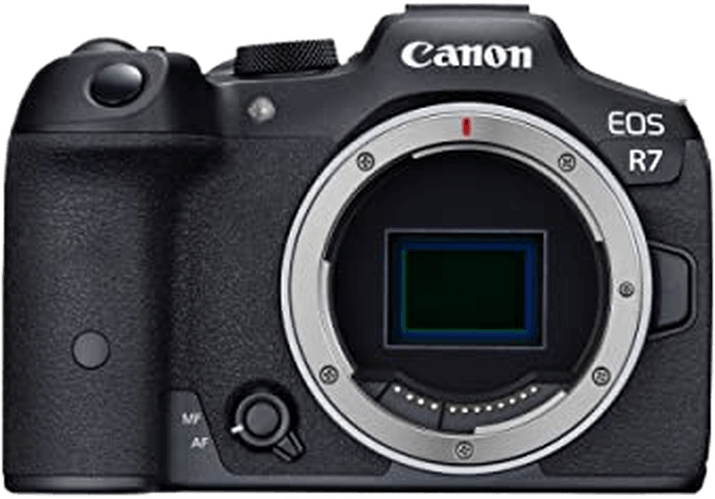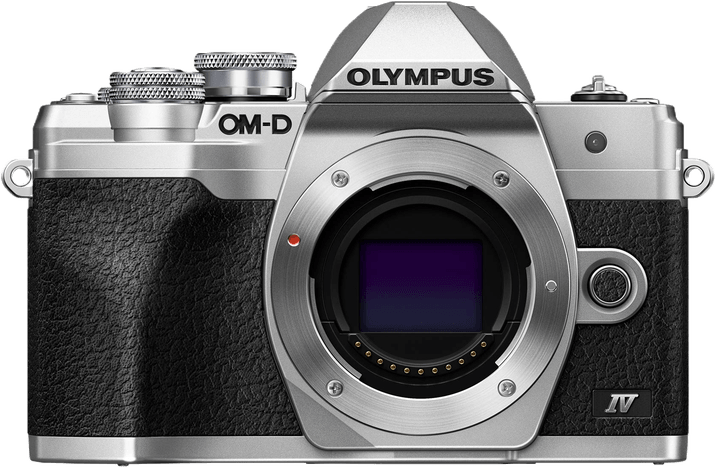Canon EOS R7 vs Olympus OM-D E-M10 Mark IV Comparison
Canon EOS R7

Olympus OM-D E-M10 Mark IV

The Canon EOS R7 wins the comparison with a score of 83/100, while the Olympus OM-D E-M10 Mark IV scores 63/100. Both cameras are mirrorless and were released in 2022 and 2020, respectively. They share similarities in their core specifications, such as camera type and size. However, the Canon EOS R7 outperforms the Olympus model with a higher launch price of $1500, a larger camera size (132 x 90 x 92mm), and a heavier weight (612g).
The Olympus OM-D E-M10 Mark IV, on the other hand, offers a more affordable option at $699 and a more compact size (122 x 84 x 49mm), making it lighter at 383g. This could be a deciding factor for users prioritizing portability and budget.
Taking everything into account, the Canon EOS R7 proves to be a superior camera with better overall performance and specifications. However, the Olympus OM-D E-M10 Mark IV still holds its own as a budget-friendly and portable alternative for those who value these aspects.
Canon EOS R7 vs Olympus OM-D E-M10 Mark IV Overview and Optics
The Canon EOS R7 triumphs over the Olympus OM-D E-M10 Mark IV in optics, boasting a score of 82/100 compared to the Olympus’ 63/100. Both cameras share similar specifications, such as a CMOS sensor, 15fps shooting speed, and image stabilization. However, the Canon EOS R7 outperforms the Olympus in various aspects, making it the better choice in terms of optics.
One advantage the Canon EOS R7 has over the Olympus OM-D E-M10 Mark IV is its higher megapixel count of 33, compared to the Olympus’ 20 megapixels. This means that the Canon EOS R7 produces higher resolution images, providing more detail and better image quality. Additionally, the Canon EOS R7 features a more advanced processor, the Digic X, compared to the Olympus’ TruePic VIII, resulting in faster image processing and better overall performance.
The Canon EOS R7 also has a higher DXOMARK sensor score of 97, compared to the Olympus’ 73, indicating superior image quality and low light performance. Furthermore, the Canon EOS R7 has a larger APS-C sensor size, which contributes to its better image quality and low light performance. Its Canon RF lens mount also offers a wider selection of lenses, providing more versatility for various shooting scenarios.
On the other hand, the Olympus OM-D E-M10 Mark IV has a 4:3 aspect ratio, compared to the Canon EOS R7’s 3:2 aspect ratio. This may be advantageous for photographers who prefer the 4:3 format for certain compositions.
Considering these factors, the Canon EOS R7 stands out as the superior choice in terms of optics, with its higher megapixel count, advanced processor, better sensor performance, and wider lens selection. The Olympus OM-D E-M10 Mark IV may still be a suitable option for those who prefer its 4:3 aspect ratio, but the Canon EOS R7 is the clear winner in this comparison.
Canon EOS R7 vs Olympus OM-D E-M10 Mark IV Video Performance
The Canon EOS R7 outperforms the Olympus OM-D E-M10 Mark IV in video capabilities, with a video score of 91/100 compared to the Olympus’ 83/100. Both cameras share common specifications, such as 4K max video resolution and 3840 x 2160 max video dimensions. Additionally, each camera has built-in time-lapse functionality.
The Canon EOS R7 excels due to its higher max video frame rate of 120fps, which is double the Olympus OM-D E-M10 Mark IV’s 60fps. This difference allows the Canon EOS R7 to capture smoother and more detailed slow-motion footage, making it the superior choice for videographers seeking high-quality video performance.
The Olympus OM-D E-M10 Mark IV, while scoring lower, still offers respectable video capabilities. Its 4K resolution and time-lapse functionality make it a viable option for casual videographers or photographers who occasionally need video functionality. However, its lower max video frame rate limits its potential in specific scenarios, such as sports or fast-moving subjects.
Considering these points, the Canon EOS R7 proves to be the better choice for those prioritizing video capabilities, with its higher video score and superior max video frame rate. The Olympus OM-D E-M10 Mark IV, while not as strong in this area, remains a practical option for casual users or those not requiring advanced video features.
Canon EOS R7 vs Olympus OM-D E-M10 Mark IV Features and Benefits
The Canon EOS R7 outperforms the Olympus OM-D E-M10 Mark IV in features, with a score of 85/100 compared to 70/100. Both cameras share several specifications, including a 3-inch screen size, touchscreen capability, flip screen, GPS absence, WiFi, and Bluetooth connectivity. Despite these similarities, the Canon EOS R7 offers a more advanced experience due to its superior features.
The Canon EOS R7 excels with a higher screen resolution of 1,620,000 dots, while the Olympus OM-D E-M10 Mark IV has a screen resolution of 1,040,000 dots. This difference enhances the user’s viewing experience and ensures more accurate composition and image review.
On the other hand, the Olympus OM-D E-M10 Mark IV has its merits despite the lower feature score. It is crucial to consider the camera’s primary use, budget, and personal preferences when deciding between these two models. The Olympus OM-D E-M10 Mark IV may be a better suited option for specific users, depending on their needs.
Taking into account the shared specifications and the Canon EOS R7’s higher feature score, it is evident that the Canon EOS R7 is the superior camera in terms of features. The increased screen resolution offers a more enjoyable and precise experience for users. However, individual preferences and intended use should be considered when choosing between these two cameras. The Olympus OM-D E-M10 Mark IV may still be a suitable option for some users, despite its lower feature score.
Canon EOS R7 vs Olympus OM-D E-M10 Mark IV Storage and Battery
The Canon EOS R7 outperforms the Olympus OM-D E-M10 Mark IV in storage and battery, scoring 79/100 compared to the Olympus’ 35/100. Both cameras accept SD, SDHC, and SDXC (UHS-II compatible) memory cards and offer USB charging. However, the Canon EOS R7 has two memory card slots, while the Olympus OM-D E-M10 Mark IV has only one.
Additionally, the Canon EOS R7 has a longer battery life of 660 shots, using the LP-E6NH battery type. In contrast, the Olympus OM-D E-M10 Mark IV’s battery life is limited to 360 shots with the BLS-50 battery type. This difference makes the Canon EOS R7 a better choice in terms of storage and battery capacity.
The Olympus OM-D E-M10 Mark IV’s only advantage in this category is its compatibility with the same memory card types as the Canon EOS R7. However, this advantage does not compensate for its lower battery life and single memory card slot.
Therefore, the Canon EOS R7 is the clear winner in storage and battery, offering more memory card slots and a longer battery life than the Olympus OM-D E-M10 Mark IV.
Canon EOS R7 vs Olympus OM-D E-M10 Mark IV – Our Verdict
Are you still undecided about which camera is right for you? Have a look at these popular comparisons that feature the Canon EOS R7 or the Olympus OM-D E-M10 Mark IV:

